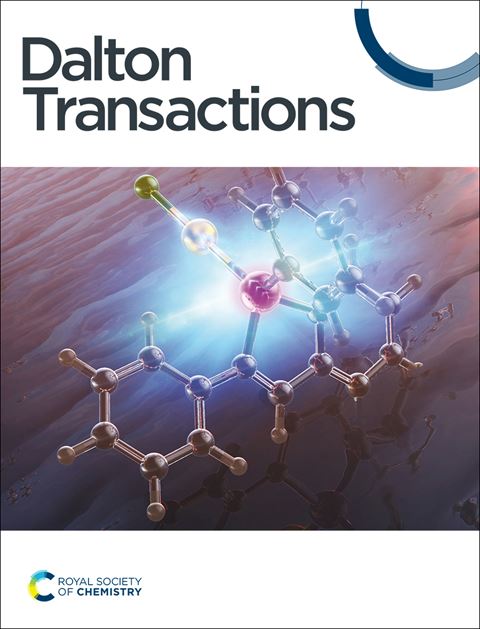用偕胺苯并咪唑功能化钌二亚胺配合物解释溶剂对磷酸二氢配合物结合的影响
IF 3.5
3区 化学
Q2 CHEMISTRY, INORGANIC & NUCLEAR
引用次数: 0
摘要
两种氨基苯并咪唑配合物[Ru(bpy)2(bbiab)](PF6)2和[Ru(phen)2(bbiab)](PF6)2(其中bbiab = 4,4 ' -双(n - 1h -苯并咪唑-2-基-羧基)-2,2 ' -联吡啶)在各种溶剂中的光物理行为表明,3MLCT状态对引入小等分溶剂(稀释)敏感,导致吸收光谱明显的增加变化,并在发射中猝灭。这种溶剂依赖性在极性介质中更为明显,并且被认为是这些配合物的“二聚化”的结果,这得到了1H-DOSY-NMR光谱和气相DFT对自由配体的研究的支持。这些配合物的pH值行为表明咪唑的质子化导致从bpy和phen配体到bbiab的发射态改变。两种配合物在引入乙酸后都发生了显著的猝灭,1H-NMR表明它与bbiab咪唑基团有关。当引入HSO4 -和H2PO4 -盐时,光物理反应表明,随着阴离子浓度的增加,存在几种不同的相互作用,酰胺和咪唑基团都可以充当氢键的供体和受体。这些效应依赖于溶剂,这意味着一系列复杂的平衡,包括咪唑在非质子溶剂中的质子化,复合体二聚体的解离,简单的一对一物种,以及磷酸二氢复合物阴离子的组合,其物种形成依赖于复合体的电荷,相关配体的疏水性和溶剂。本文章由计算机程序翻译,如有差异,请以英文原文为准。
Interpreting solvent effects on complex dihydrogenphosphate binding using amidobenzimidazole functionalised emissive ruthenium diimine complexes
The photophysical behaviour of two amidobenzimidazole complexes, [Ru(bpy)2(bbiab)](PF6)2 and [Ru(phen)2(bbiab)](PF6)2 (where bbiab = 4,4`-bis(N-1H-benzimidazol-2-yl-carboxamidyl)-2,2`-bipyridine) in a variety of solvents suggest that the 3MLCT state is sensitive to the introduction of small aliquots of solvent (dilution) resulting in distinct incremental changes to the absorption spectra, and quenching in emission. This solvent dependency is more pronounced in polar media and is proposed to be a consequence of “dimerization” of these complexes, which is supported by 1H-DOSY-NMR spectroscopy and gas phase DFT studies on the free ligands. The pH behaviour of these complexes indicates that protonation of the imidazole results in changing the emissive state from the bpy and phen ligands to bbiab. Significant quenching in both complexes is seen on the introduction of acetate, which 1H-NMR spectroscopy suggests is association with the bbiab imidazole groups. On the introduction of HSO4− and H2PO4− salts, the photophysical response suggests several distinct interactions are present as anion concentration increases, with both the amide and imidazole groups able to act as hydrogen-bond donors and acceptors. These effects are solvent dependent implying a complex set of equilibria, ranging from protonation of the imidazole in non-protic solvents, dissociation of the complex dimer, a simple one-to-one species, and a combined bis(dihydrogenphosphate)-complex anion, with speciation reliant on complex charge, associated ligand hydrophobicity, and solvent.
求助全文
通过发布文献求助,成功后即可免费获取论文全文。
去求助
来源期刊

Dalton Transactions
化学-无机化学与核化学
CiteScore
6.60
自引率
7.50%
发文量
1832
审稿时长
1.5 months
期刊介绍:
Dalton Transactions is a journal for all areas of inorganic chemistry, which encompasses the organometallic, bioinorganic and materials chemistry of the elements, with applications including synthesis, catalysis, energy conversion/storage, electrical devices and medicine. Dalton Transactions welcomes high-quality, original submissions in all of these areas and more, where the advancement of knowledge in inorganic chemistry is significant.
 求助内容:
求助内容: 应助结果提醒方式:
应助结果提醒方式:


